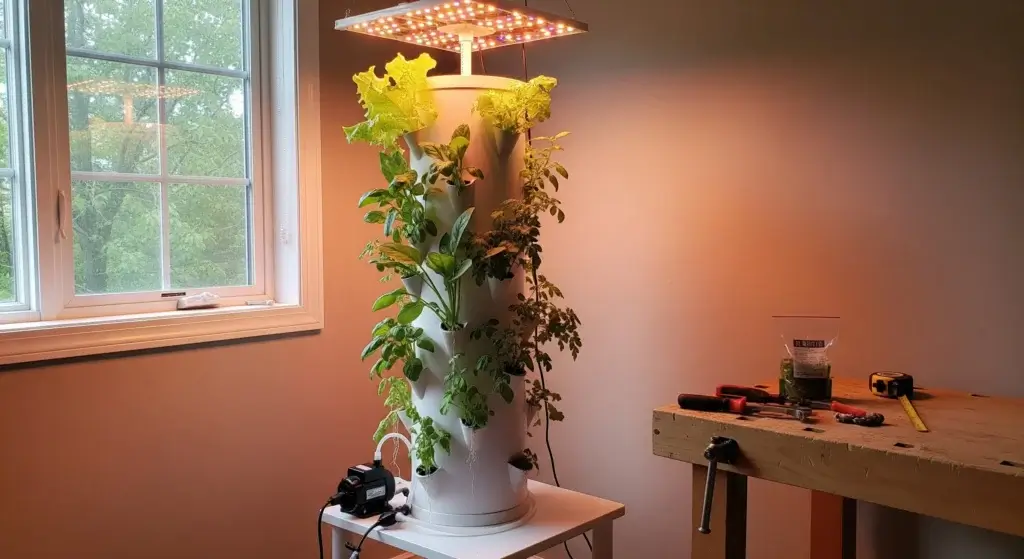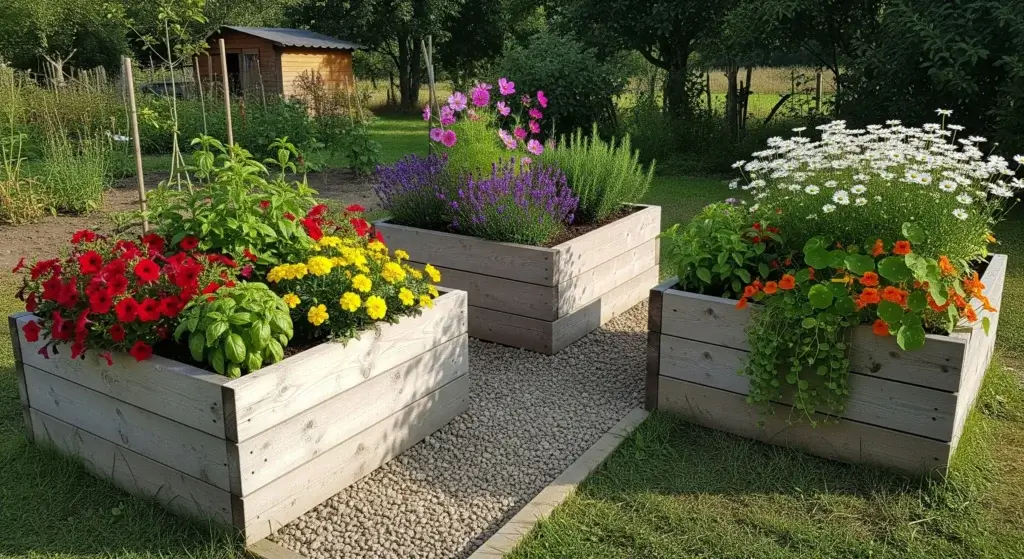
Dreaming of a chill garden setup like a true plant boss?
A potting bench is your new best friend—perfect for starting seeds, repotting plants, or just finally finding your trowel.
The kicker? You don’t need to drop major cash on a fancy one. Grab some scrap wood and basic tools, and boom—you’re building your own.
Making a DIY potting bench from leftovers isn’t just budget-friendly—it’s eco-hero level.
You’re saving wood from the dump and creating a setup that fits your vibe.
Think of it as a gardening glow-up, minus the price tag.
This guide covers everything from planning to the last coat of paint. Let’s get your hands dirty (in a good way).
Why Choose a DIY Potting Bench Over Store-Bought Options?
So, why bother building your own potting bench instead of buying one off the shelf?
Easy—money, fit, and durability.
Cost savings
Store-bought benches can cost anywhere from $150 to $500. That’s a lot of mulch.
With scrap wood and some basic screws, you can build one for under $50. That’s like… two bags of fertilizer and a fancy coffee.
Fit
Most benches you buy come in one-size-fits-none.
Got a weird corner in your shed or a tiny patio? Good luck. But when you DIY, you control the size.
Want a shelf for your seed trays or a hook for your gloves? You’re the boss.
Durability
A lot of store benches are made with flimsy materials that wilt faster than basil in the sun.
When you build your own with solid scrap wood—like cedar, pine, or whatever’s lying around—you’re making something that can handle dirt, water, and time.
Think of it as the Captain America of garden furniture: strong, reliable, and built to last.

- Read also: The Guide to Creating a DIY Living Wall Garden for Your Apartment
- Read also: DIY Homemade Garden Tool Storage: 12 Creative Solutions
Planning Your DIY Potting Bench Project
Essential tools and materials
Before starting your potting bench project, gather these essential tools:
- Circular saw or miter saw
- Drill with bits
- Measuring tape
- Level
- Sandpaper (120 and 220 grit)
- Safety glasses and dust mask
- Clamps
- Square or speed square
Materials you’ll need:
- Scrap wood boards (2x4s for frame, 1x6s or 1x8s for surfaces)
- Wood screws (2.5-inch and 1.5-inch)
- Wood glue
- Hardware cloth or chicken wire (optional, for lower shelf)
- Wood stain or paint (optional)
- Polyurethane finish (recommended for durability)
Designing Your Potting Bench
Think of your potting bench like the Batcave for your garden gear—everything should be where you need it, when you need it.
Start with the basics: most folks go with 48″ wide, 24″ deep, and 36″ tall. But hey, you’re not most folks.
If you’re tall and tired of hunching like Gollum over your plants, bump the height up to 38–40″. Your spine will thank you.
Here’s what to include if you want your bench to feel like a true garden command center:
- Upper shelf for storing pots and supplies
- Lower shelf for bulk materials like soil and mulch
- Side hooks for hanging tools
- Built-in measuring rulers along the edges
- Removable work surface for easy cleaning

Step-by-Step Construction Guide
Alright, let’s break this down like a friend walking you through a weekend project with snacks, power tools, and a Spotify playlist.
Step 1: Preparing your scrap wood
Start by digging through your wood stash—aka the “future projects” pile.
Look for boards that are straight and not full of nails, cracks, or woodpecker holes.
If you’ve got cedar or redwood, jackpot! They handle moisture like champs.
Pine and fir? Totally fine—just show them some extra love over time.
Give everything a good scrub and sand with 120-grit so you don’t get splinters mid-repot.
And check for surprise nails—you’re building a bench, not a tetanus trap.
Step 2: Building the frame structure
Now for the bones. Cut four legs from 2x4s—usually 36″ tall, unless you’re Shaq. Then cut:
- Two long rails at 45″
- Two short rails at 21″
- A couple cross supports so the whole thing doesn’t wobble like a folding chair at a BBQ.
Screw it all together with 2.5″ wood screws and some glue.
Pre-drill holes so you don’t split the wood and ruin your groove.
Use a square to keep it aligned—this ain’t abstract art.
Step 3: Creating the work surface
This is your stage. The spot where the magic (and mess) happens.
Use your nicest boards here. Got wide pieces like 2x10s? Sweet. One or two of those, and you’re golden.
If your boards are skinny, just glue a few side by side.
Leave little gaps—like 1/8”—so water and soil don’t pool up like your inbox on Monday morning.
Sand it smooth with 120- then 220-grit so it feels like butter and doesn’t chew up your seedlings or your hands.
Step 4: Adding storage solutions
Time to trick it out with features that make life easier.
- Put a shelf 12–15″ above the work surface for pots and odds and ends.
- Use chicken wire or hardware cloth for the bottom shelf—it’s strong, breathable, and dirt falls right through.
Want extra flair?
- Hang dowels on the sides for tools
- Add trays for seeds, labels, and snacks (again, no judgment)
- Mount a paper towel holder—because things will get messy
- Bonus: attach a tiny trash bin underneath. Instant upgrade.
Step 5: Finishing and weather protection
Even if it’s living under a roof, moisture is sneaky.
Sand the whole thing down again with 220-grit to smooth out any drama. Then pick a finish:
- Polyurethane – strong, shiny, and made for the outdoors
- Tung oil – natural and artsy, with decent protection
- Exterior paint – go bold or stay neutral. Either way, it’ll last
- Danish oil – easy to use, easy to touch up
Apply thin coats and sand lightly between if you’re going pro-mode. And then? You’re done.

Maximizing Your Potting Bench Functionality
You’ve built the bench—now let’s make it work for you.
Think of this part like setting up your dream coffee bar, but for plants.
Organizing your workspace
A cluttered bench = a chaotic brain.
Hang your go-to tools (trowels, pruners, spray bottles) on hooks so you’re not always digging through a mess like you’re in a garden-themed escape room.
Add a small drawer or shelf for your seed packets.
Sort them by season so when spring hits, you’re not wondering where your tomatoes ran off to.
Bonus points if you keep labels and markers handy—future you will thank you when you forget if that sprout is basil or weeds.
Seasonal maintenance tips
Your potting bench works hard. Show it some love—especially after each planting season.
Give it a good wipe-down, tighten any wobbly screws, and fix up scuffed finishes so it stays looking sharp.
Monthly check-in:
- Sweep off dirt and leaves (and maybe snack crumbs?)
- Check for loose screws or wiggly parts
- Oil any hinges or moving bits
- Look for signs of rot or creepy-crawlies setting up shop
Treat it like you would a bike or your favorite kitchen knife—it’ll last forever if you do.
Customization ideas for different needs
Your bench should grow with you.
Into seed starting? Add some grow lights above the workspace and channel your inner greenhouse scientist.
Love herbs? Mount a little sink nearby for quick rinsing and watering—kitchen garden meets spa day.
Tight on space? Build a fold-down bench that attaches to a wall or fence.
Flips up when you’re done, kind of like a Murphy bed, but for dirt.

Troubleshooting Common Issues
Built your bench but it’s acting a little off? No worries—DIY means “Do It Your Way,” and sometimes that includes a few bumps along the way.
Here’s how to fix the usual suspects:
Dealing with uneven scrap wood
Reclaimed wood is like a mystery box—sometimes it’s gold, sometimes it’s a banana.
If your boards aren’t the same thickness, use a planer if you’ve got one.
If not, lean into the rustic charm and arrange your top like it’s intentional.
Think shabby chic, not garage sale regret.
Got a board that’s doing yoga (aka super warped)?
Cut it into smaller, straighter strips, or hide it in the frame where no one will see it.
It’s still pulling its weight, just behind the scenes—like a garden version of Alfred from Batman.
Stability problems
If your bench is rocking like it’s at a 90s punk concert, you need braces—diagonal ones.
Add some between the legs to stabilize it fast, no full rebuild required.
You can also slap a cross-brace across the back, which adds strength and space to hang tools or shelves. Win-win.
Weather resistance issues
Peeling finish? Wood looking weathered already? You probably skipped prep (don’t worry, we’ve all done it). Here’s the fix:
Strip the old finish, give everything a solid sanding (go smooth with 220-grit), then hit it with a quality primer before adding your final coat.
That extra step is like primer before makeup—makes the topcoat pop and stay put.
- Read also: DIY Garden Arches and Pergolas: Step by Step Guide
- Read also: How to Build a DIY Rainwater Harvesting System for Your Garden
Wrap-Up: Your Garden Bench Glow-Up
Building your own potting bench from scrap wood is a total win—budget-friendly, eco-conscious, and way more fun than buying one off a shelf.
Plus, it’s a great intro to basic woodworking without needing full Bob Vila energy.
Take your time: smooth those boards, make strong joints, and add a finish that can handle mud, water, and your daily garden chaos.
Customize it to fit your space and your plant-parenting style.
Extra hooks? Built-in ruler? Tiny sink? Go for it.



